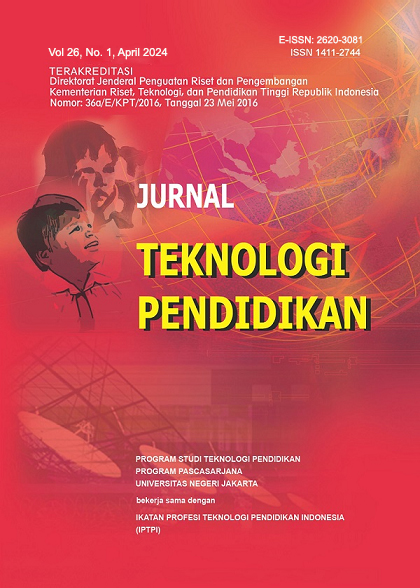Development of Learning Media in The Subject of Network Infrastructure Administration
DOI:
https://doi.org/10.21009/jtp.v26i2.47907Keywords:
Learning Media, Network Infrastructure Administration, Flash MediaAbstract
This research aims to develop learning media for class The research method used is the R&D method using the four-D development model. The four-D development model consists of Define, Design, Development, and Disseminate. The results obtained from this development research are learning media based on Adobe Flash Professional CS6. Based on the research results, it can be concluded that the media developed is declared valid in the media aspect at 85.42%, the material aspect with results at 80.83%. The media developed is practical with a practical value from teacher responses with results of 90.14% and student responses of 89.60%, and the resulting learning media has been effectively used with posttest results seen from students' classical completeness of 88% and a gain score of 0 .38 in the medium category. The conclusion is that the Adobe Flash Professional CS6-based learning media developed can be used and is feasible in the learning process to improve student learning outcomes.
Learning Media, Adobe Flash Professional CS6, Network Infrastructure Administration
References
Afrianto, A., & Wirayudha, R. (2024). Analisis Kebutuhan E-Modul Pada Mata Pelajaran Fikih Kelas X Di MA Darul Ulum Palangka Raya. Edification Journal Pendidikan Agama Islam, 6(2), 99–110. https://doi.org/10.37092/ej.v6i2.656
Azmi, K. (2022). Pembuatan Media Interaktif Kondom Kateter Untuk Meningkatkan Keterampilan Mahasiswa Kebidanan. Jurnal Sustainable: Jurnal Hasil Penelitian Dan Industri Terapan, 11(1), 1–7.
Fadhilah, F., & Husin, M. (2023). Student Readiness on Online Learning in Higher Education: An Empirical Study. International Journal of Instruction, 16(3), 489–504. https://doi.org/10.29333/iji.2023.16326a
Fadhilah, Husin, M., & Fadia Raddhin, R. (2023). JIPF (JURNAL ILMU PENDIDIKAN FISIKA) The Effectiveness of Project-Based Learning (PjBL) on Learning Outcomes: A Meta-Analysis Using JASP. JIPF (Jurnal Ilmu Pendidikan Fisika), 8(3), 327–336. https://doi.org/10.26737/jipf.v8i3.3701
Firdaus, F., Sukmawati, M., Ambiyar, A., & Fadhilah, F. (2023). Studi Literature Penggunaan Media Pembelajaran Berbasis Moodle pada Sekolah Kejuruan. JAVIT: Jurnal Vokasi Informatika, 133–139. https://doi.org/10.24036/javit.v3i3.163
Hikmah Fajar, A., Mukhaiyar, R., & Islami, S. (2023). Pengembangan E-Modul Interaktif Instalasi Penerangan Listrik di Pendidikan Vokasi. Jurnal Pendidikan Teknik Elektro, 4(1), 111–116.
Isma, T. W., Tasrif, E., Huda, Y., & Syah, N. (2021). Analisis Konten Modul Pelajaran Mikrokontroller Terhadap Keterampilan Berpikir Kritis dan Kreativitas Siswa Sekolah Menengah Kejuruan. EDUKATIF: Jurnal Ilmu Pendidikan, 4(1), 582–589. https://doi.org/10.31004/edukatif.v4i1.1891
Marta, R., Ambiyar, Fadhilah, & Firdaus. (2024). Kontribusi Motivasi Belajar dan Penggunaan Media Pembelajaran Terhadap Hasil Belajar. JTeKI (Jurnal Teknik Komputer Dan Informatika), 4(1), 25–30. http://jteki.ppj.unp.ac.id
Nopriyanti. (2015). Pengembangan Multimedia Pembelajaran Interaktif Kompetensi Dasar Pemasangan Sistem Penerangan dan Wiring Kelistrikan di SMK. Jurnal Pendidikan Vokasi, 5(2), 222–233.
Riduwan. (2010). Skala Pengukuran Variabel-variabel Penelitian. Alfabeta.
Rohim, I. A., & Jaya, P. (2019). Perancangan Dan Pembuatan Media Pembelajaran Augmented Reality Pada Pengajaran Teknik Elektronika. Voteteknika (Vocational Teknik Elektronika Dan Informatika), 7(3).
Slameto. (2010). Belajar dan faktor-faktor yang Mempengaruhinya. PT. Rineka Cipta.
Sugiyono. (2013). Metode Penelitian Kuantitatif, Kualitatif dan R&D. Alfabeta.
Taali, T., Pulungan, A. B., Hambali, H., & Angraini, A. (2021). Studi Kelayakan Sistem Grounding Di Fakultas Pariwisata Dan Perhotelan Universitas Negeri Padang. JTEV (Jurnal Teknik Elektro Dan Vokasional), 7(2), 328. https://doi.org/10.24036/jtev.v7i2.114829
Yustina, A. F., & Yahfizham, Y. (2023). Game Based Learning Matematika dengan Metode Squid game dan Among us. Jurnal Pendidikan Matematika, 7(1), 615–630.
Downloads
Published
How to Cite
Issue
Section
License
Jurnal Teknologi Pendidikan is an Open Access Journal. The authors who publish the manuscript in Jurnal Teknologi Pendidikan agree to the following terms.
Attribution-ShareAlike 4.0 International (CC BY-SA 4.0)
-
Attribution — You must give appropriate credit, provide a link to the license, and indicate if changes were made. You may do so in any reasonable manner, but not in any way that suggests the licensor endorses you or your use.
-
ShareAlike — If you remix, transform, or build upon the material, you must distribute your contributions under the same license as the original.
- No additional restrictions — You may not apply legal terms or technological measures that legally restrict others from doing anything the license permits.
Notices:
- You do not have to comply with the license for elements of the material in the public domain or where your use is permitted by an applicable exception or limitation.
- No warranties are given. The license may not give you all of the permissions necessary for your intended use. For example, other rights such as publicity, privacy, or moral rights may limit how you use the material.








